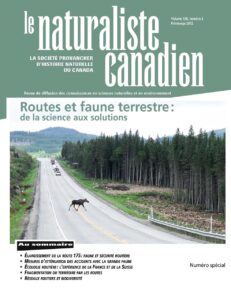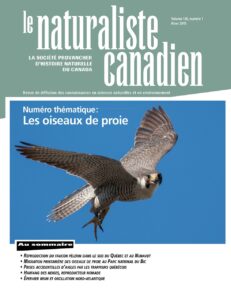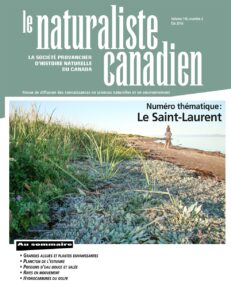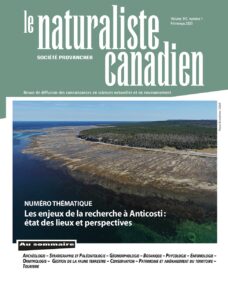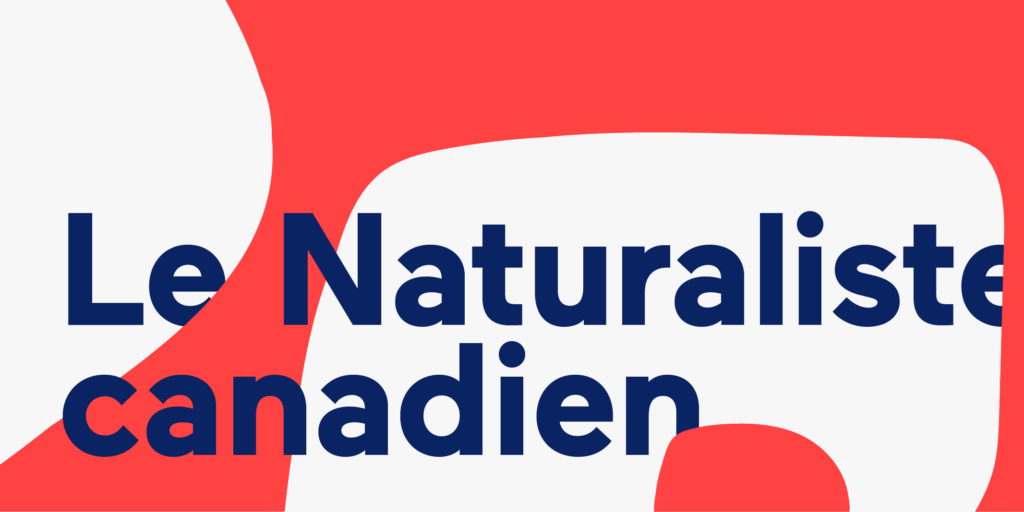
For this fourth interview in the series, Érudit talked with Le Naturaliste canadien, which disseminates knowledge, in French, on themes regarding nature and environment in North America. The journal is currently directed by Denise Tousignant, an expert scientific editor who is certified in the life sciences and works for the Direction de la recherche forestière at the Ministère des Ressources naturelles et des Forêts (MRNF).
1. Le Naturaliste canadien is the oldest French-language scholarly journal covering the natural sciences in North America. Could you tell us the story of how it was founded and how it has managed to survive to this day?
At every step of its evolution, the journal has managed to find people willing and capable of carrying on its mission. It was supported by passionate individuals and institutions who wanted to continue the work done by Reverend Léon Provancher, who founded the journal in 1868. Reverend Victor-A. Huard took up the torch in 1894, followed by Université Laval in 1929 and then the Société Provancher d’Histoire naturelle in 1994 [1].
Throughout the journal’s history, important decisions have been made to position the journal in the wider world of scientific publishing. After a period where the journal looked for a more international and English-speaking readership (1929-1966), the decision was made to return to the original vocation of disseminating scientific information on natural sciences in French. In 2012, the journal joined the Érudit platform in order to disseminate its content electronically in addition to its print version, for greater reach. In 2020, Le Naturaliste canadien abandoned its print version, becoming entirely digital.
The team is also working on a project aimed at digitizing and indexing its archives. Rendering available the articles published over 150 years is seen as an invaluable heritage [2].
_____________________________________
[1] Perron, J.-M., 2001, La course à relais du Naturaliste canadien. Le Naturaliste canadien, 125(2) : 6-10.
[2] Tousignant, D., 2022. Un patrimoine inestimable maintenant disponible! Le Naturaliste canadien, 146(1): 2.
2. Le Naturaliste canadien publishes articles covering the natural sciences which are read by a wide audience, mainly composed of scientists and naturalists. Could you tell us more about your readership and how publishing in French has allowed you to better reach your audience?
Le Naturaliste canadien chooses to publish articles exclusively in French, because its team firmly believes that this is the best way for the journal to fulfil its mission and address the issues which resonate with its readership. The uncontested dominance of English in the world of scientific publishing creates a distortion that hides or minimizes the scope and complexity of issues that affect certain regions or certain linguistic minorities around the world [3].
Le Naturaliste canadien does not claim to compete with international English-language journals like Nature or Science. The journal occupies a specific niche, offering a window into the work done in the natural and environmental sciences in Québec and North America. Its content is primarily aimed at scientists, researchers, managers and naturalists in Eastern Canada who study ecosystems in a North American context. In that sense, its aim is to satisfy an essential need. Moreover, that does not prevent it from reaching francophone readers around the world and even beyond the French-speaking world, through the English abstracts and keywords. In fact, its readership has been increasing ever since it joined the Érudit platform [4]. In recent years, annual statistics of Le Naturaliste canadien on Érudit have exceeded 60,000 visits and 48,000 article downloads.
_____________________________________
[3] Tousignant, D. et Y. Pouliot, 2022, Le Naturaliste canadien à une table ronde de revues francophones. Le Naturaliste canadien, 146(2) : 2.
[4] Cimon, A. et D. Tousignant, 2021. La première année du Naturaliste canadien tout numérique : un franc succès! Le Naturaliste canadien, 145(1) : 2.
3. In a context where we see an internationalization of research, especially in the natural sciences, what are some myths that need to be deconstructed to attract high-quality manuscripts?
The first myth to deconstruct is the paramount value of the impact factor (the number of times that an article is cited), which is a criterion that is highly valued in the world of scientific publishing when ranking journals and which helps authors choose where to publish. While this factor provides an enviable level of visibility and is heavily taken into consideration by funding agencies, it does include important biases and does not necessarily reflect how well a journal is reaching its target audience or account for the other impacts of a publication. There are other criteria to consider when choosing a journal in which to publish, for example the target audience, the numbers of visitors its articles have attracted and the number of downloads for its content [5]. To these, one can add the quality of the editorial support provided to authors, the publication fees (we have none) and the dissemination policy (our articles are available only to our subscribers for a period of 12 months after their publication, after which they are available in open access).
A second myth to deconstruct, related to the first one, is the regional or international reach of an article. Some research funding agencies push authors to favour journals with an international reach, on the premise that this provides a wider readership. However, contrary to national journals, international journals are not necessarily read by the community concerned with the region studied. A study conducted by Vincent Larivière of the Université de Montréal mentions that “national journals are used by the community as often as the “large” international journals are, and much more than the journals published by the large-scale publishers.” [6]
A third myth to deconstruct is that French-language articles are not read. While English dominates the scientific field to a large degree, the French-speaking world does represent a demographic pool for more than 300 million people. Moreover, the presence of an English abstract adds international visibility to articles published in other languages, and those who then wish to access the content of the article itself can turn to powerful instantaneous translation tools powered by artificial intelligence.
_____________________________________
[5] Larivière, V., 2014, De l’importance des revues de recherche nationales.
[6] Larivière, V., 2014, op. cit.
4. In 1994, the Société Provancher reassumed leadership of the journal and is now using it as its main channel of communication with its members, relying on the involvement of many volunteers. Could you tell us more about its operation?
The Société Provancher, which sponsors and funds the journal, uses volunteers for all its activities, and this is also true of the production of Le Naturaliste canadien. The journal relies on about thirty volunteers, including the managing editor, two assistant managing editors, seven members of the executive committee, ten assistant editors, eight technical and linguistic reviewers, three proofreaders, and a marketing/communication manager. Around this core, several other volunteers from the Société Provancher provide IT and administrative support, as well as help with communications. A part-time assistant to the managing editor is the only person receiving a salary.
The managing editor oversees the whole operation and assumes most of the special responsibilities related to the mission of the journal. She is supported in her daily tasks by an assistant and receives guidance from the executive committee. Financial matters are handled in collaboration with the board of directors of the Société Provancher, which funds the journal.
When a scientific article is submitted, the managing editor delegates the responsibility of conducting its scientific review to one of her assistant managing editors. After a pre-reading, the associate editor with the relevant specialization in the discipline covered by the article is assigned the task of finding experts to participate in the scientific peer review. At the same time, volunteers review the more technical aspects of the manuscript. The manuscripts which pass the peer review then undergo meticulous linguistic and typographical editing before being sent for graphic layout. Other volunteers write additional content (tributes, book reviews, etc.) and help with the proofreading. Finally, the marketing manager writes the announcements to promote new content when it becomes available, and works on improving the global visibility of the journal.
5. Could you showcase a few articles published in Le Naturaliste canadien which highlight the diversity of the themes being covered?
Le Naturaliste canadien publishes articles written by authors of various backgrounds from academia, government, private organizations and non-profits. We also regularly receive submissions by independent naturalists. The subjects being covered span the entire range of the natural and environmental sciences: botany, conservation, entomology, marine environments, ornithology, mammalogy, forestry, history, mycology, ocean sciences, herpetology, malacology, paleontology, geomorphology, etc. From time to time, we publish thematic issues that cover particular subject matters, the most recent ones being: Routes et faune terrestre — de la science aux solutions (Roads and land fauna, from science to solutions) (2012), Les oiseaux de proie (Birds of prey) (2015), Le Saint-Laurent (The Saint-Lawrence) (2016), the 20e anniversaire du parc marin du Saguenay–Saint-Laurent : recherche, conservation et mise en valeur (20th anniversary of the Marine Park of Saguenay-Saint-Laurent: research, conservation and development) (2018), Colloque sur l’écologie routière et adaptation aux changements climatiques — de la recherche aux actions concrètes (Conference on road ecology and adaptations to climate change, from research to concrete measures) (2019) and Les enjeux de la recherche à Anticosti — état des lieux et perspectives (Issues of Research in Anticosti: Current Situation and Perspectives) (Spring 2023).
Here are some examples of the diversity of subject matters and authors that we publish:
Conservation and sustainable development: the article Risques et impacts associés à l’exploration et à l’exploitation des hydrocarbures dans le golfe du Saint-Laurent, written by Sylvain Archambault (Société pour la nature et les parcs) and Jean-Patrick Toussaint (David Suzuki Foundation) in the thematic issue titled Le Saint-Laurent, has attracted the most attention from our readers over the last few years. The PDF for the article has been downloaded over 12,900 times and remains our most read article since its publication in 2016.
Aquatic environments: the article Biosuivi du marais Léon-Provancher depuis sa mise en eau (1996-2016) : implications pour la conservation d’un milieu humide aménagé, written by Julie Robitaille (INRS), Émilie Saulnier-Talbot (Université Laval) and Isabelle Lavoie (INRS), is a good example of research applied to a regional context. The article received the Gisèle-Lamoureux award from the FRQNT for French-langage publication in September 2021, and its PDF file has been downloaded over 340 times since its publication in fall 2020.
Entomology: the article Sur les traces de l’épithèque de Provancher au mont Yamaska (Odonata : Corduliidae : Neurocordulia yamaskanensis) is a fascinating study conducted by Alain Mochon and Michel Savard, two self-taught entomologists who retraced the path taken by Reverend Léon Provancher (the founder of our journal) as they tried to find a species of dragonfly that the Reverend had first described in 1875. The article was published in the issue celebrating the 150-year anniversary of Le Naturaliste canadien in 2018.
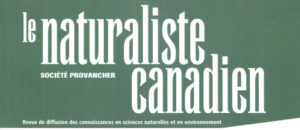
Curious to learn more about scholarly journals? Read the other interviews in the “5 questions with…” series.
